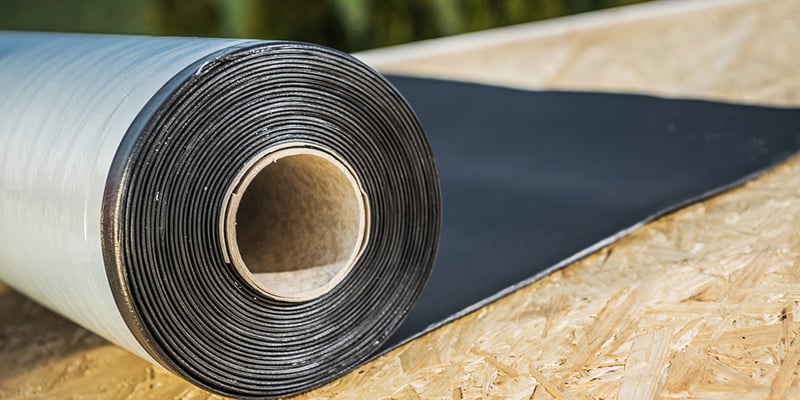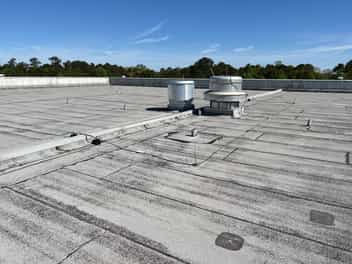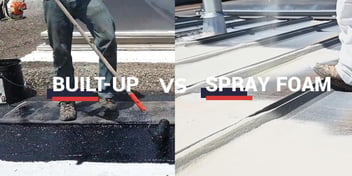- Home »
- Learningcenter »
- What roofing base sheets
FAQ: What Are Roofing Base Sheets and The Different Types?

Have you ever looked at what's beneath the top layer of a roof? It's pretty fascinating how it's similar to a house's foundation - the parts you don't usually see are the most meaningful.
In roofing one of these really useful hidden features is the base sheet. It plays a big part in protecting buildings from the features. Below the visible parts like shingles or tiles - the base sheet can actually act like the real foundation of the roof system which helps make sure that the entire setup lasts longer and stays tougher.
Are you curious to study roofing systems starting with base sheets? Join me in looking at the really noteworthy layers that keep our buildings safe and sound. This knowledge is definitely helpful to have for anyone interested in the structural health of their home or commercial property.
Different Types of Base Sheets
Base sheets are super important for building a tough and useful roof. Think of base sheets as the starting point of all roofing systems - they're the first layer that sets everything up for the following ones. Throughout my career, I've seen all sorts of base sheets, each customized to meet the requirements for different roofs and all sorts of conditions. This number is all possible because of the regular updates in roofing technology.
Let's talk about built-up roofing (BUR) base sheets first. These sheets can add things like multiple layers and might have things like felt fiberglass or polyester. They can be soaked with normal asphalt or sometimes a stronger material called modified bitumen. I find this mix really solid. Though old-school BUT is still liked because it's awesome at waterproofing and lasts a long time. Many of my clients go for this when durability is a big concern.
Next, we have modified bitumen base sheets, which mix in polymers like SBS and APP to help with the asphalt's properties. I really like SBS-modified base sheets for roofs that need to stay flexible and perform well in cooler climates since SBS gives a rubbery feel. For hotter places, I tell people to pick APP-modified sheets because they're great at dealing with thermal expansion and UV rays, keeping their shape even in tough conditions.

Hybrid systems are pretty cool too. These mix the proven strength of BUR with the latest upgrades of modified bitumen. This combo has a balance of sturdiness and flexibility - perfect for places with changing weather. I've seen that roofs with hybrid systems like to perform really well bringing together the top features of both types.
Lastly, let's talk about single-ply roofing systems, which also sometimes add base sheets. Even though these systems usually trust a single layer, adding a base sheet can really help with the roof's performance. It's useful to know what these base sheets are made of, as they really affect the overall toughness of the roof. Usually, they're made of strong things like reinforced polyester, which is impressive for handling structural changes and rough weather.
Picking the right base sheet is a good idea for extending the lifespan and functionality of your roof if for commercial buildings or residential homes. It's a good idea to think about the environment and the building's needs when picking a good choice base sheet. This knowledge will make sure that your roof stays in top shape for years to come.
What Are Built-Up Roofing Base Sheets Used For?
When I first got into roofing, figuring out all the complicated language was pretty hard. One thing that caught my eye early on was Built-Up Roofing (BUR) base sheets. Getting this down was important to understanding multi-layer roofing systems.
The process kicks off by laying the base sheet right on the roof's insulation or cover board. Here's an interesting bit - these base sheets are soaked with asphalt or modified bitumen major for waterproofing and durability. As the foundational layer the base sheet teams up with extra layers of roofing felt and bitumen. They're stacked up one after the other to form a solid barrier against the features.
I've had the chance to watch this installation process up close, and it's pretty cool to see how careful it is. The base sheets can be either mechanically fastened or glued down with things like hot asphalt or cold-applied adhesives. This flexibility makes BUR a smart choice for all kinds of project needs.

Picture this: a commercial building in a place with harsh winters and wet springs. Here a BUR system would usually add multiple layers of base sheets each acting as a guard against potential leaks and structural damage from freezing and thawing cycles. Plus the system includes built-in backup - if one layer gets messed up others jump in to keep the roof's integrity.
The benefits of BUR base sheets are pretty clear in changing climates. They have great durability and are really good at resisting tears and punctures which is useful because regular roof repairs are a pain.
Even with the arrival of new technologies and parts, the proven effectiveness of BUR base sheets in providing solid waterproofing and protection still stands out in the roofing industry. So, when you're lining up a roofing project, knowing the valuable part of base sheets in BUR systems is a good idea - they ensure a tough and secure roofing setup.
How Do Modified Bitumen Base Sheets Work?
So, I've been working with roofing parts for quite a while now, and I need to show how smart it is to pick the right base sheet for your roofing project. This is especially true for the Modified Bitumen Roofing System, a top pick for all sorts of buildings because of its durability and flexibility.
Now, let's talk about the base sheets - your real options here. You've mainly got two types: SBS and APP modified bitumen base sheets. Think of these sheets as the ultimate foundation for your roof sticking directly to the substrate to make sure everything else on top works perfectly.
SBS (Styrene-Butadiene-Styrene) modified bitumen base sheets are awesome for colder regions. They toss in a rubber-like component SBS which improves the roofing material's stretchability and flexibility. That's a huge plus in cold weather where parts might otherwise snap. SBS sheets stay solid quickly adapting to expansion and contraction.
For the hotter places, APP (Atactic Polypropylene) modified bitumen sheets are your best bet. They mix in a plastic polymer that helps the bitumen stand up to UV rays and aging. These sheets need more heat during installation, which is no problem in warmer areas. The added heat will make sure everything fuses together, keeping leaks away.

In my roofing work, if I go with APP or SBS sheets, it really shapes how I strategize the job. To give you an example, APP sheets typically work best with the torch-down method for a tight seal. SBS sheets, on the other hand, are super flexible - both cold adhesives and hot-mopping are useful depending on what you're dealing with.
Picking between SBS and APP should definitely depend on the local weather and the building's design - each roof is perfectly customized to its environment.
Honestly, picking the right parts and methods can majorly shift how well a roofing system performs. Getting the knowledge of these differences has absolutely steered me toward making useful choices in my projects!
Venting Base Sheets
Venting base sheets have really made their mark on the roofing industry, especially with built-up roofing (BUR) and modified bitumen systems. I think these sheets are valuable for improving the durability and functionality of roof systems over lightweight insulating concrete decks. They have a cool design - a glass fiber mat coated with filled coating-grade asphalt and a bottom finished with coarse mineral granules.
This smart configuration addresses the annoying issue of trapped moisture, letting it escape and preventing damage. It's especially helpful during installations over concrete decks where managing moisture is a good idea.
Looking closer, venting base sheets comply with the strict ASTM D 4897 Type II standards. Meeting these tough requirements will make sure the sheets can handle the needs of all sorts of roofing systems. They weigh between 0.75 and 0.95 pounds per square foot and come in rolls that cover either 100 or 150 square feet. These sheets during construction give a solid foundation, increase toughness and strengthen the overall membrane. Besides, it really reduces the risk of moisture and alkalinity damage.

Practically speaking, to give you an example, when working over a deck of lightweight insulating concrete, venting base sheets can replace traditional cover boards and shield the sensitive polyiso insulation from heat. I really appreciate how this dual part makes the layering process easier in typical complicated roofing systems. Usually, you'd have a lineup of a vapor retarder and insulation - maybe an overlay cover board - all topped off with these base sheets and a cap sheet.
With their intelligent design and material composition venting base sheets address common roofing challenges over difficult substrates. With a combination of protection strength and moisture management these sheets are a tough and practical choice for improving today's roofing systems. If it's protecting against moisture or extending the roof's lifespan these sheets are definitely a smart choice.
Self-Adhered Base Sheets
Self-adhered base sheets are pretty awesome in the roofing industry - they make jobs noticeably easier. What really stands out is their pre-applied adhesive backing. This makes the whole installation process way easier, something we all love since it improves work efficiency and also tackles safety and environmental issues.
These sheets usually consist of modified bitumen - basically asphalt mixed with either rubber or plastic polymers like Styrene-Butadiene-Styrene (SBS) or Atactic Polypropylene (APP). This mix creates a tough material that works with common installation challenges. To give you an example, SOPRALENE® Stick from SOPREMA, which is a modified bitumen reinforced with a non-woven polyester mat, has extra durability and a fine mineral aggregate for better surface protection. It also has a protective polyolefin release film on the bottom.
When it comes to installation, products like GAF's LIBERTY™ Self-Adhering Base/Ply Sheet are super easy to use. Each sheet has a pressure-sensitive adhesive on the underside covered by a split release liner - basically just peel and stick. This gets rid of the need for torches, open flames, or hot asphalt. It speeds up the process and cuts down the usual risks tied to traditional methods.

A lot of these self-adhered sheets are reinforced with things like polyester fiberglass or composites. These reinforcements help with their toughness and increase their lifespan.
They're typically pretty thick, too - around 98 mils (2.5 mm) to 106 mils (2.7 mm), which gives a solid foundation for just about any roofing system.
In practice these sheets are great for multi-ply membrane and flashing assemblies with a reliable base for later layers. They are especially meaningful in places where safety is a big focus or environmental rules limit the use of open flames or the emission of volatile organic compounds (VOCs) during installation. Looking at these aspects you can see how these cool roofing parts simplify the job. They also help with safety and compliance. Their adaptability in all sorts of projects shows their usefulness and flexibility in meeting different roofing needs.
Installation and Maintenance Best Practices
When it comes to installing and maintaining base sheets on a roof it's smart to take your time and focus on the details. Making sure that base sheets are securely attached to the roof deck is important. You have a couple of options here - either use a cold-applied adhesive or mechanically fasten them with nails or other sturdy fasteners. Applying the adhesive evenly is major to prevent leaks and extend the life of your roof.
Connecting base sheets to other parts of the roof, like flashings and drainage systems, is also really valuable for maintaining a watertight seal. This prevents water from seeping in and causing damage. A useful tip is to start installing base sheets from the lowest part of the roof and work your way up. Doing this helps make sure each sheet fits snugly around every bend and corner, keeping away from any gaps or loose areas.
Beyond assembling everything correctly, it's a good idea to check your roof now and again and address any minor issues right away. I usually recommend inspecting your roof periodically to catch any potential problems early. Over the years, I've spotted a few minor tears and loose seams, which I fixed up quickly without much hassle.

I'm also a big advocate for reflective coatings. Slapping on two coats of asphalt flashings covers the asphalt better and bounces back UV rays. This cuts down on heat absorption by the roof, which can help it last longer.
Pay attention to the temperature when working with asphalt. Stick to the manufacturer's recommendations for the best conditions - this is especially useful in cooler climates, as not following the cold-weather guidelines can really mess with your installation.
Lastly I can't stress enough the importance of staying away from roofing work in bad weather. Putting in roof parts in rain snow or on wet surfaces can trap moisture leading to serious problems. Taking the time to install everything properly and committing to regular maintenance can really help with the performance and longevity of your roof.
Protect The Roof Over Your Head
So, talking about roofing systems might not usually grab your attention, but getting to know a bit about the base sheets and the other layers underneath can make a huge difference.
Think of it as dressing for a cold day - you wouldn't just skip the warm base layer, right? In the same way, when you're picking built-up roofing modified bitumen or even some cool hybrid systems that combine things like BUR and modified bitumen, those bottom layers are important to your roof's ability to hang tough against Mother Nature and last for a long time.

Picking the right base sheet is far from a small thing - it's actually a big deal. Why risk the safety and longevity of your building? That's why making smart choices about your roofing is important.
Don't you think that listening to some expert advice could avoid a never-ending cycle of repairs and instead lead to a tough, low-maintenance roof?
Here at Colony Roofers, we have tons of experience in both commercial and residential roofing across Georgia, Florida, and Texas, and our job is to help protect your investment. We totally understand how valuable a reliable roof is for your safety. So, why not give us a shout for a free inspection? We'd be super excited to show you why so many people trust Colony Roofers for their roofing needs.
 Call (678) 365-3138
Call (678) 365-3138



